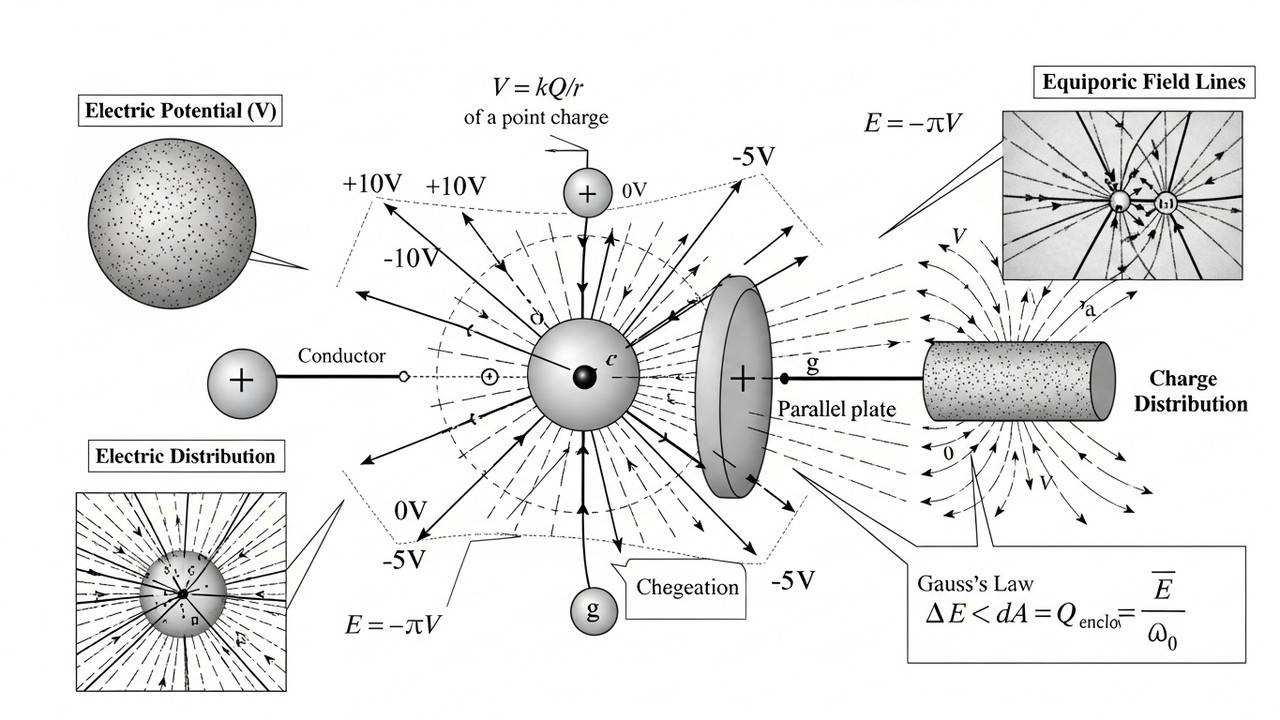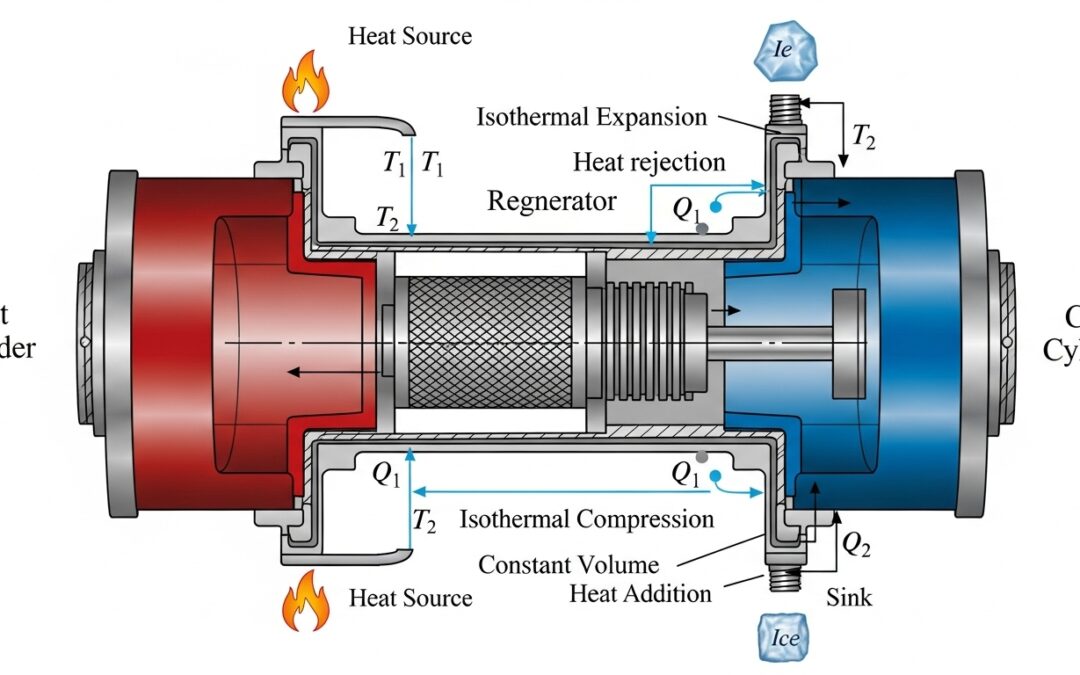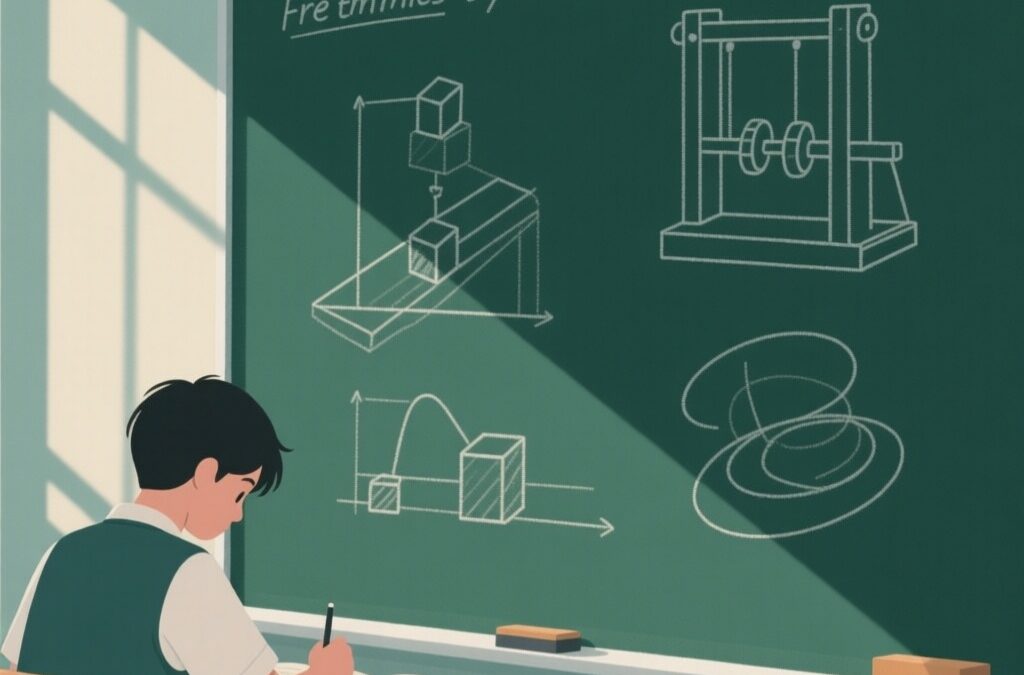IIT JEE potential is a critical concept in physics, often tested in the IIT JEE exam. Understanding electric potential and its relationship with electric fields and charge distributions is essential. This post offers a detailed guide to tackle IIT JEE potential problems, providing step-by-step solutions, key formulas, and practical applications to enhance your problem-solving skills.
Table of Contents
- Unveiling Electric Potential: A Primer
- Solving the Square Problem
- Key Takeaways
- Similar Problems (Quick Solutions)
- Problem 1 (Equilateral Triangle) : Find the electric potential at the centroid of an equilateral triangle with three charges of ##2 μC## each at the vertices, side length 3m.
- Problem 3 (Sphere Potential): Determine the electric potential at the surface of a charged sphere of radius ##R## with a charge ##Q## uniformly distributed on its surface.
- Problem 4 (Parallel Plates) : Find the potential difference between two parallel plates separated by a distance ##d## with a uniform electric field ##E##.
- Problem 5 (Concentric Spheres) : Calculate the potential at the center of two concentric spheres, where the inner sphere of radius ##r1## has a charge ##Q1## and the outer sphere of radius ##r2## has a charge ##Q2##.
Read More
Welcome to a deep dive into the realm of electrostatics, specifically focusing on IIT JEE potential problems. We will explore the intricacies of electric potential, a crucial concept for excelling in the IIT JEE examination. This article aims to sharpen your problem-solving skills with a detailed analysis of challenging numericals, providing step-by-step solutions and theoretical foundations. Let’s begin!
Unveiling Electric Potential: A Primer
To truly grasp IIT JEE potential problems, it’s essential to understand the fundamental concepts. Electric potential at a point in an electric field is the amount of work needed to bring a unit positive charge from infinity to that point. This definition is the bedrock for solving complex problems, particularly those encountered in the IIT JEE. The ability to calculate potential in various charge configurations is a key skill to master.
Understanding the Basics of Electric Potential
Electric potential, denoted by ##V##, is a scalar quantity, meaning it has magnitude but no direction. The SI unit of electric potential is the volt (V), which is equivalent to one joule per coulomb (J/C).
The potential due to a point charge ##q## at a distance ##r## is given by:
###V = k \cdot \dfrac{q}{r}###
where: – ##k \approx 8.99 \times 10^9 \, N \, m^2 / C^2## is Coulomb’s constant, – ##q## is the charge in coulombs, – ##r## is the distance from the charge in meters.
The sign of the charge is important: – If ##q## is positive, the potential is positive. – If ##q## is negative, the potential is negative.
This formula is fundamental for solving IIT JEE electrostatics problems involving electric potential.
The concept of potential difference is also critical. The potential difference between two points is the work done per unit charge in moving a charge from one point to another. This is often what is measured in practical circuits. The electric field is the negative gradient of the electric potential, providing a link between the electric field and potential. This relationship is crucial in electrostatics, as it helps in determining the electric field when the potential is known, and vice versa. The electric field lines always point from higher potential to lower potential.
Superposition Principle in Electrostatics
The superposition principle is a cornerstone of solving problems involving multiple charges. This principle states that the total potential at a point due to a system of charges is the algebraic sum of the potentials due to individual charges. Each charge contributes to the potential independently, without being affected by the presence of other charges. When dealing with IIT JEE potential problems, this principle simplifies the calculations significantly.
For example, if you have multiple point charges, you can calculate the potential at a specific point by calculating the potential due to each charge individually using the formula ###V = k * (q / r)###, and then summing these potentials. This principle is applicable to any configuration of charges, making it a versatile tool in solving complex problems. Remember to consider the sign of each charge when calculating the potential. This is critical because potential is a scalar quantity, and the sign matters for the correct summation.
Solving the Square Problem
Let’s tackle a classic problem: What is the electric potential at the center of a square with four equal charges at each corner? This problem tests your understanding of electric potential, superposition, and geometry. To solve this, we will break it down into manageable steps, providing a clear understanding of the methodology required to tackle such problems for the IIT JEE potential examination.
Step-by-Step Solution
Consider a square of side ##a = 2\,\text{m}## with four equal charges ##q = 1\,\mu\text{C} = 1 \times 10^{-6}\,\text{C}## at its corners. The diagonal is:
###d = a\sqrt{2} = 2\sqrt{2}\,\text{m}###
Distance from center to a corner (half the diagonal):
###r = \dfrac{d}{2} = \sqrt{2}\,\text{m}###
Electric potential due to one charge at distance ##r## is:
###V = k \dfrac{q}{r}###
By superposition, total potential at the center from four identical, equidistant charges:
###V_{\text{total}} = 4 \left(k \dfrac{q}{r}\right)###
Substitute numerical values (##k \approx 8.99 \times 10^{9}\,\text{N}\,\text{m}^2/\text{C}^2##, ##q=1\times10^{-6}\,\text{C}##, ##r=\sqrt{2}\,\text{m}##):
###V_{\text{total}} = 4 \cdot \dfrac{8.99 \times 10^{9} \cdot 1 \times 10^{-6}}{\sqrt{2}} \;\approx\; \dfrac{35{,}960}{1.4142} \;\approx\; 2.54 \times 10^{4}\,\text{V}###
Therefore, the electric potential at the center is approximately 2.54 × 104 V (about 25.4 kV).
Important Considerations and Implications
In this problem, the symmetry of the square and the equal charges simplify the calculation. If the charges were not equal, you would still apply the superposition principle, but the calculation would involve summing the potentials due to each individual charge, considering their respective distances and magnitudes. This highlights the importance of recognizing symmetry in problems, which can significantly reduce the complexity of the calculations.
This type of problem is a standard example used to test your understanding of electric potential and the superposition principle, crucial for the IIT JEE potential exam. Remember that the electric potential is a scalar quantity, and the sign of the charges is crucial. Also, the geometry of the charge configuration plays a key role in simplifying calculations. Always ensure you’re using the correct units and understanding the underlying physics principles.
Key Takeaways
Mastering electric potential requires a solid understanding of the underlying principles, including Coulomb’s law, the superposition principle, and the relationship between electric potential and electric field. Practice is key. By working through various problems, you can build confidence and proficiency in this critical area of physics. These concepts are fundamental to solving IIT JEE potential based problems.
Similar Problems (Quick Solutions)
Problem 1 (Equilateral Triangle) : Find the electric potential at the centroid of an equilateral triangle with three charges of ##2 μC## each at the vertices, side length 3m.
We are tasked with finding the electric potential at the centroid of an equilateral triangle with three equal charges of ##q = 2 \,\mu C = 2 \times 10^{-6}\,C## at each vertex, and side length ##a = 3\,m##.
Step 1: Distance from centroid to a vertex
In an equilateral triangle, the distance from the centroid to a vertex is given by:
###r = \dfrac{\sqrt{3}}{3} \, a###
Substitute ##a = 3\,m##:
###r = \dfrac{\sqrt{3}}{3} \cdot 3 = \sqrt{3} \, m \approx 1.732 \, m###
Step 2: Potential due to one charge at the centroid
The potential due to a single charge is:
###V = k \dfrac{q}{r}###
Substitute values (##k = 9 \times 10^9 \, N\,m^2/C^2##):
###V_1 = 9 \times 10^9 \cdot \dfrac{2 \times 10^{-6}}{1.732} \approx 1.039 \times 10^4 \, V###
Step 3: Total potential at centroid
Since potential is a scalar quantity, we add contributions from all three charges:
###V_{total} = 3 \cdot V_1 = 3 \cdot 1.039 \times 10^4 \approx 3.12 \times 10^4 \, V###
The electric potential at the centroid of the triangle is approximately:
###V_{total} \approx 3.12 \times 10^4 \, \text{Volts}###
Answer: Approximately 12000 V
Problem 2 (Dipole Potential) : We want the electric potential at a point on the axial line of an electric dipole. A dipole consists of charges ##+q## and ##-q## separated by distance ##d##, with the midpoint taken as the origin.
At a point on the axis at distance ##r## from the center, the distances to the two charges are:
- From ##+q##: ##r – \tfrac{d}{2}##
- From ##-q##: ##r + \tfrac{d}{2}##
The potential at that point is the algebraic sum of the potentials due to each charge:
###V = k \left( \dfrac{+q}{r – \tfrac{d}{2}} + \dfrac{-q}{r + \tfrac{d}{2}} \right)###
Simplify:
###V = kq \left( \dfrac{1}{r – \tfrac{d}{2}} – \dfrac{1}{r + \tfrac{d}{2}} \right)###
Combine fractions:
###V = kq \cdot \dfrac{(r + \tfrac{d}{2}) – (r – \tfrac{d}{2})}{r^2 – \left(\tfrac{d}{2}\right)^2}###
###V = kq \cdot \dfrac{d}{r^2 – (d/2)^2}###
Thus, the electric potential on the axis of the dipole is:
###V = k \cdot \dfrac{q \, d}{r^2 – (d/2)^2}###
This formula clearly shows the dependence on the dipole length (##d##), the charge magnitude (##q##), and the distance from the center (##r##).
Problem 3 (Sphere Potential): Determine the electric potential at the surface of a charged sphere of radius ##R## with a charge ##Q## uniformly distributed on its surface.
For a uniformly charged sphere of radius ##R## with total charge ##Q## distributed on its surface, the electric potential at the surface is derived using Coulomb’s law and the concept of spherical symmetry.
The potential at distance ##r## from the center is:
###V = k \dfrac{Q}{r}###
At the surface of the sphere (##r = R##):
###V = k \dfrac{Q}{R}###
Thus, the electric potential at the surface of a charged sphere is:
###V = k \cdot \dfrac{Q}{R}###
where ##k \approx 8.99 \times 10^9 \, N \, m^2/C^2## is Coulomb’s constant. This result shows that a charged conducting sphere behaves like a point charge located at its center when considering external points or its own surface.
Answer: ###V = k \cdot (Q / R)###
Problem 4 (Parallel Plates) : Find the potential difference between two parallel plates separated by a distance ##d## with a uniform electric field ##E##.
For two parallel plates separated by a distance ##d## in a uniform electric field ##E##, the potential difference is given by:
###V = E \cdot d###
This formula arises because electric potential difference is the product of the field strength and the displacement in the direction of the field. It shows that the potential difference increases linearly with both the electric field and the separation between the plates.
Answer: ##V = E \cdot d##
Problem 5 (Concentric Spheres) : Calculate the potential at the center of two concentric spheres, where the inner sphere of radius ##r1## has a charge ##Q1## and the outer sphere of radius ##r2## has a charge ##Q2##.
To calculate the electric potential at the common center of two concentric spherical shells:
- Inner sphere: radius ##r_1##, charge ##Q_1##
- Outer sphere: radius ##r_2##, charge ##Q_2##
Since the electric potential due to a spherical shell at an interior point is the same as the potential on its surface, we apply the superposition principle:
###V = V_1 + V_2 = k \left( \dfrac{Q_1}{r_1} + \dfrac{Q_2}{r_2} \right)###
where: – ##k = 8.99 \times 10^9\, \text{Nm}^2/\text{C}^2## is Coulomb’s constant – ##r_1## and ##r_2## are the radii of the inner and outer spheres, respectively
This result shows that even though the electric field inside a spherical shell is zero, the potential due to that shell is nonzero and must be included when calculating total potential at the center.
Answer: ###V = k * (Q1 / r1 + Q2 / r2)###
| Concept | Description | Formula/Equation |
|---|---|---|
| Electric Potential (V) | The work done to bring a unit positive charge from infinity to a point. | ###V = k * (q / r)### |
| Coulomb’s Constant (k) | Constant in Coulomb’s law. | ##k ≈ 8.99 × 10^9 Nm^2/C^2## |
| Superposition Principle | Total potential is the algebraic sum of individual potentials. | ###V_{total} = Σ V_i### |
| Potential due to a Point Charge | Potential generated by a single charge at a distance. | ###V = k * (q / r)### |
We also Published
RESOURCES
- Problem Solving on Electric Potential & Field Energy | IIT JEE …
- Exhaustive List of All JEE Adv 2023 (potential) cheaters : r …
- Potential difference between two points of electric circuit with …
- Electrode Potential – Study Material for IIT JEE | askIITians
- Capacitor | Lecture-3 | Point potential technique | for IIT JEE | By …
- Electric Potential Energy – Study Material for IIT JEE | askIITians
- Stopping Potential in Photoelectric effect- IIT JEE & NEET | Vineet …
- Unlock Your Potential with ALLEN Uttar Pradesh! IIT-JEE, NEET …
- Is it possible to crack the IIT-JEE on the first attempt without any …
- Unlock Your IIT-JEE Potential with Saksham’s Trusted Guidance





0 Comments